Evaluating the Impact of Human Activities on Vegetation Restoration in Mining Areas Based on the GTWR
Abstract
1. Introduction
2. Materials and Methods
2.1. Study Area and Data
2.2. Methodology
2.2.1. Data Acquisition and Pre-Processing
2.2.2. Selection of Meteorological Data
2.2.3. Extraction of NDVI-HA
2.2.4. Evaluation of Trends in Vegetation Growth
3. Results
3.1. Spatio-Temporal Characteristics of Vegetation Cover
3.2. Driving Processes of Vegetation Growth in Natural Conditions
3.3. Spatio-Temporal Patterns of Impact of Human Activities on Vegetation Restoration
3.4. Comparison of the Impacts of Natural Factors and Human Activities on the Vegetation Restoration
4. Discussion
4.1. Associations between Restoration Measures and NDVI-HA
- Preventing surface subsidence and cracks: Regular observations are conducted on the cracks and sinkholes that emerge on the surface as a result of mining, and timely backfilling of surface subsidence and cracks is undertaken. The gangue produced by the coal preparation plant is transformed into filling material and used to fill the underground sinkholes, thereby reducing the ecological impact of gangue discharge and reducing the extent of surface subsidence in the sinkholes.
- Reforestation and reclamation of the mining area: Approximately 50,000 trees and shrubs, along with green hedges, are planted in the industrial site. In reclamation areas susceptible to soil erosion and land desertification, locally suitable shrubs and grass species that thrive in the local environment are carefully chosen.
- Establishing a green safeguard mechanism: To ensure the geological environmental protection and land reclamation of the Shangwan Mine, a long-term green safeguard mechanism has been implemented. The mine has developed various guidelines and protocols, including the “Safe Management Measures for Tree Pruning”, “Green Maintenance Techniques”, “Landscape Greening and Management Measures for Mining Service Companies”, “Inspection and Maintenance Procedures for Green Maintenance”, “Responsibility Scope for Green Maintenance”, “Greening and Management Measures for Shangwan Service Department”, and the “Annual Green Maintenance Management Plan”.
- Ensuring the effect of greening: A specialized service contract for the greening and maintenance project within the central zone of Inner Mongolia has been established between the Shangwan Mine and an external contracting company. The company has been entrusted with the responsibilities of watering, greening, and fertilizing the vegetation within the factory area.
4.2. Relationship between Vegetation Restoration and Temperature & Precipitation
4.3. Limitations and Future Work
5. Conclusions
- The GTWR model was applied to construct a quantitative relationship between vegetation growth and driving factors in the mining area for the first time. The impact of natural factors was separated by the residual analysis, so that the vegetation changes caused by human activities in the mining area could be assessed separately.
- Over the past three decades, more than 90% of the area in the study area showed an improving trend, with 84.68% was extremely significant improvement. The NDVI-HA of the study area was generally positive under the environment with mining activities from 2000 to 2020 where human activities were intense, with an increasing trend over the time, particularly significant after 2013. Spatially, the areas degraded due to human activities were concentrated in the open-pit mining area in the lower right corner, and the vicinity of transfer site and building area of the Shangwan Mine, where the surface vegetation was removed due to the direct land occupation. Furthermore, the spatial heterogeneity of vegetation restoration was attributed to the DEM. It is negatively correlated with NDVI in natural conditions, while under the environment of mining activities, there is a positive correlation between NDVI-HA and DEM. The areas with higher elevation were more impacted by human activities.
- The study conducted a comparative analysis of the impacts of temperature, precipitation, and human activities on vegetation restoration. The findings reveal that the contribution of human activities to vegetation restoration in the mining area has been gradually increasing from 2000 to 2020. After 2010, the contribution of human activities exceeded that of temperature and precipitation, becoming the dominant factor influencing vegetation growth in the mining area. In comparison, precipitation exhibited a higher contribution to vegetation restoration than temperature.
Author Contributions
Funding
Data Availability Statement
Conflicts of Interest
References
- Li, S.J.; Zheng, X.; Sui, Y.Z. Research progress in evaluation of ecological restoration effects. Acta Ecol. Sin. 2021, 41, 4240–4249. [Google Scholar] [CrossRef]
- Xu, H.L.; Xu, F.J.; Lin, T.; Xu, Q.; Yu, P.J.; Wang, C.H.; Aili, A.; Zhao, X.F.; Zhao, W.Y.; Zhang, P.; et al. A systematic review and comprehensive analysis on ecological restoration of mining areas in the arid region of China: Challenge, capability, and reconsideration. Ecol. Indic. 2023, 154, 110630. [Google Scholar] [CrossRef]
- Xu, D.L.; Li, X.F.; Chen, J.; Li, J.H. Research Progress of Soil and Vegetation Restoration Technology in Open-Pit Coal Mine: A Review. Agriculture 2023, 13, 226. [Google Scholar] [CrossRef]
- Chen, L.F.; Zhang, H.; Zhang, X.Y.; Liu, P.H.; Zhang, W.C.; Ma, X.Y. Vegetation changes in coal mining areas: Naturally or anthropogenically Driven? Catena 2022, 208, 105712. [Google Scholar] [CrossRef]
- Zhang, X.Y.; Liu, Y.; Chen, X.Y.; Long, L.L.; Su, Y.D.; Yu, X.K.; An, S.K. Analysis of spatial and temporal changes of vegetation cover and its driving forces in the Huainan mining area. Environ. Sci. Pollut. Res. Int. 2022, 29, 60117–60132. [Google Scholar] [CrossRef]
- Hui, J.W.; Chen, Z.X.; Ye, B.Y.; Shi, C.; Bai, Z.K. Remote Sensing Monitoring of the Spatial Pattern of Greening and Browning in Xilin Gol Grassland and Its Response to Climate and Human Activities. Remote Sens. 2022, 14, 1765. [Google Scholar] [CrossRef]
- Shivesh, K.K.; Sukha, R.S.; Subodh, K.M. Assessment of the capability of remote sensing and GIS techniques for monitoring reclamation success in coal mine degraded lands. J. Environ. Manag. 2016, 182, 272–283. [Google Scholar] [CrossRef]
- Hui, J.W.; Bai, Z.K.; Ye, B.Y.; Wang, Z.H. Remote Sensing Monitoring and Evaluation of Vegetation Restoration in Grassland Mining Areas—A Case Study of the Shengli Mining Area in Xilinhot City, China. Land 2021, 10, 743. [Google Scholar] [CrossRef]
- Yu, H.X.; Zahidi, I.; Chow, M.F. Vegetation as an ecological indicator in assessing environmental restoration in mining areas. Iscience 2023, 26. [Google Scholar] [CrossRef]
- Bao, N.S.; Lechner, A.M.; Johansen, K.; Ye, B.Y. Object-based classification of semi-arid vegetation to support mine rehabilitation and monitoring. J. Appl. Remote Sens. 2014, 8, 083564. [Google Scholar] [CrossRef]
- Wang, W.; Liu, R.Y.; Gan, F.P.; Zhou, P.; Zhang, X.W.; Ding, L. Monitoring and Evaluating Restoration Vegetation Status in Mine Region Using Remote Sensing Data: Case Study in Inner Mongolia, China. Remote Sens. 2021, 13, 1350. [Google Scholar] [CrossRef]
- Liu, Y.; Lei, S.G.; Chen, X.Y.; Chen, M.; Yang, Y.M.; Li, X.H.; Zhang, X.Y.; Long, L.L.; Dian, Z.F. Temporal variation and driving factors of vegetation coverage in Shendong central mining area based on the perspective of guided restoration. J. China Coal Soc. 2021, 46, 3319–3331. [Google Scholar] [CrossRef]
- Bi, Y.L.; Liu, T. Time series analysis of multi-source data of coordinated evolution of vegetation in open-pit mining area: Taking Jungar Mining Area as an example. Coal Sci. Technol. 2022, 50, 293–302. [Google Scholar]
- Bao, N.S.; Lechner, A.; Fletcher, A.; Erskine, P.; Mulligan, D.; Bai, Z.K. SPOTing long-term changes in vegetation over short-term variability. Int. J. Min. Reclam. Environ. 2014, 28, 2–24. [Google Scholar] [CrossRef]
- Zhang, K.; Lü, Y.H.; Fu, B.J.; Li, T. The effects of restoration on vegetation trends: Spatiotemporal variability and influencing factors. Earth Environ. Sci. Trans. R. Soc. Edinb. 2019, 109, 473–481. [Google Scholar] [CrossRef]
- Ren, H.; Zhao, Y.L.; Xiao, W.; Li, J.Q.; Yang, X. Influence of management on vegetation restoration in coal waste dump after reclamation in semi-arid mining areas: Examining ShengLi coalfield in Inner Mongolia, China. Environ. Sci. Pollut. Res. Int. 2021, 28, 68460–68474. [Google Scholar] [CrossRef]
- Li, S.J.; Wang, J.M.; Zhang, M.; Tang, Q. Characterizing and attributing the vegetation coverage changes in North Shanxi coal base of China from 1987 to 2020. Resour. Policy 2021, 74, 102331. [Google Scholar] [CrossRef]
- Qi, D.N.; Hu, Z.J.; Zhao, S.M. Long-term NDVI spatio-temporal variation trend and its response to climate in Xishan coalfield, Shanxi province. Bull. Surv. Mapp. 2021, 9, 98–102, 107. [Google Scholar] [CrossRef]
- Dong, J.W.; Tao, F.L.; Zhang, G.L. Trends and variation in vegetation greenness related to geographic controls in middle and eastern Inner Mongolia, China. Environ. Earth Sci. 2011, 62, 245–256. [Google Scholar] [CrossRef]
- Fu, X.; Ma, M.F.; Jiang, P.; Quan, Y. Spatiotemporal vegetation dynamics and their influence factors at a large coal-fired power plant in Xilinhot, Inner Mongolia. Int. J. Sustain. Dev. World Ecol. 2016, 24, 433–438. [Google Scholar] [CrossRef]
- Du, H.D.; Ning, B.Y.; Bai, M.T.; Fan, P.H. Dynamic Change of Vegetation Coverage and its Driving Forces in Different Landforms on Yushenfu Mining Area from 1990 to 2019. For. Resour. Manag. 2021, 5, 121–130. [Google Scholar] [CrossRef]
- Zhang, C.Y.; Li, F.Y.; Li, J.; Zhang, K.; Ran, W.Y.; Du, M.H.; Guo, J.T.; Hou, G.F. Assessing the effect, attribution, and potential of vegetation restoration in open-pit coal mines’ dumping sites during 2003–2020 utilizing remote sensing. Ecol. Indic. 2023, 155, 111003. [Google Scholar] [CrossRef]
- Huang, B.; Wu, B.; Barry, M. Geographically and temporally weighted regression for modeling spatio-temporal variation in house prices. Int. J. Geogr. Inf. Sci. 2010, 24, 383–401. [Google Scholar] [CrossRef]
- Fotheringham, A.S.; Crespo, R.; Yao, J. Geographical and Temporal Weighted Regression (GTWR). Geogr. Anal. 2015, 47, 431–452. [Google Scholar] [CrossRef]
- Yang, W.; Yao, Q.Y.; Wu, B.Y.; Xie, X.H.; Yu, L.Q.; Li, Y.H.; Wang, L.J. Strength Damage and Acoustic Emission Characteristics of Water-Bearing Coal Pillar Dam Samples from Shangwan Mine, China. Energies 2023, 16, 1692. [Google Scholar] [CrossRef]
- Lv, S.; Wang, X.G.; Chen, Y.P. Talking about green mine construction in Shangwan Coal Mine. China Coal 2023, 49, 41–45. [Google Scholar] [CrossRef]
- Tian, F.; Fensholt, R.; Verbesselt, J.; Grogan, K.; Horion, S.; Wang, Y.J. Evaluating temporal consistency of long-term global NDVI datasets for trend analysis. Remote Sens. Environ. 2015, 163, 326–340. [Google Scholar] [CrossRef]
- May, J.L.; Parker, T.; Unger, S.; Oberbauer, S.F. Short term changes in moisture content drive strong changes in Normalized Difference Vegetation Index and gross primary productivity in four Arctic moss communities. Remote Sens. Environ. 2018, 212, 114–120. [Google Scholar] [CrossRef]
- van Aert, R.C.M.; Goos, C. A critical reflection on computing the sampling variance of the partial correlation coefficient. Res. Synth. Methods 2023, 14, 520–525. [Google Scholar] [CrossRef]
- Li, J.; Peng, S.P.; Zhang, C.Y.; Yang, F.; Sang, X. Quantitative remote sensing-based monitoring and evaluation of the ecological environment in mining areas: Technology framework and application. J. Min. Sci. Technol. 2022, 7, 9–25. [Google Scholar] [CrossRef]
- Li, J.; Xu, Y.L.; Zhang, C.Y.; Guo, J.T.; Wang, X.J.; Zhang, Y.C. Unmixing the coupling influence from driving factors on vegetation changes considering spatio-temporal heterogeneity in mining areas: A case study in Xilinhot, Inner Mongolia, China. Environ. Monit. Assess. 2022, 195, 224. [Google Scholar] [CrossRef]
- Li, Q.S.; Xu, Y.L.; Li, J.; Zhang, C.Y.; Guo, J.T.; She, C.Z.; Song, Z.H.; Wang, F. Extraction of the impact of mining on vegetation changes and quantitative analysis of ecological cumulative effects based on long time series multi-source data. J. China Coal Soc. 2022, 6, 2420–2434. [Google Scholar] [CrossRef]
- Stow, D.; Daeschner, S.; Hope, A.; Douglas, D.; Petersen, A.; Myneni, R.; Oechel, W. Variability of the Seasonally Integrated Normalized Difference Vegetation I-ndex Across the North Slope of Alaska in the 1990s. Int. J. Remote Sens. 2003, 24, 1111–1117. [Google Scholar] [CrossRef]
- Wang, M.Y.; Fu, J.E.; Wu, Z.T.; Pang, Z.G. Spatiotemporal variation of NDVI in the vegetation growing season in the source region of the Yellow River, China. ISPRS Int. J. Geo-Inf. 2020, 9, 282. [Google Scholar] [CrossRef]
- Li, Y.; Zheng, Z.C.; Qin, Y.C.; Rong, P.J. Relative contributions of natural and man-made factors to vegetation cover change of environmentally sensitive and vulnerable areas of China. J. Clean. Prod. 2021, 321, 128917. [Google Scholar] [CrossRef]
- Sun, Q.Y.; Liu, W.W.; Gao, Y.N.; Li, J.S.; Yang, C.Y. Spatiotemporal variation and climate influence factors of vegetation ecological quality in the sanjiangyuan national park. Sustainability 2020, 12, 6634. [Google Scholar] [CrossRef]
- Guo, Y.L.; Yang, J.Z.; He, A.M.; Li, N.K. Discussion on the construction of green mine pilot unit in Shangwan coal mine. Shaanxi Coal 2013, 6, 18–20. [Google Scholar]
- Zhang, M.; Lin, H.; Long, X.G.; Cai, Y.T. Analyzing the spatiotemporal pattern and driving factors of wetland vegetation changes using 2000–2019 time-series Landsat data. Sci. Total Environ. 2021, 780, 146615. [Google Scholar] [CrossRef]
- Mu, B.H.; Zhao, X.; Wu, D.H.; Wang, X.Y.; Zhao, J.C.; Wang, H.Y.; Zhou, Q.; Du, X.Z.; Liu, N. Vegetation cover change and its attribution in China from 2001 to 2018. Remote Sens. 2021, 13, 496. [Google Scholar] [CrossRef]
- Wu, H.F.; Zhang, J.Y.; Bao, Z.X.; Wang, G.Q.; Wang, W.S.; Yang, Y.Q.; Wang, J.; Kan, G. The impacts of natural and anthropogenic factors on vegetation change in the Yellow-Huai-Hai River Basin. Front. Earth Sci. 2022, 10, 959403. [Google Scholar] [CrossRef]
- Feng, X.J.; Tian, J.; Wang, Y.X.; Wu, J.J.; Liu, J.; Ya, Q.; Li, Z.S. Spatio-Temporal Variation and Climatic Driving Factors of Vegetation Coverage in the Yellow River Basin from 2001 to 2020 Based on kNDVI. Forests 2023, 14, 620. [Google Scholar] [CrossRef]

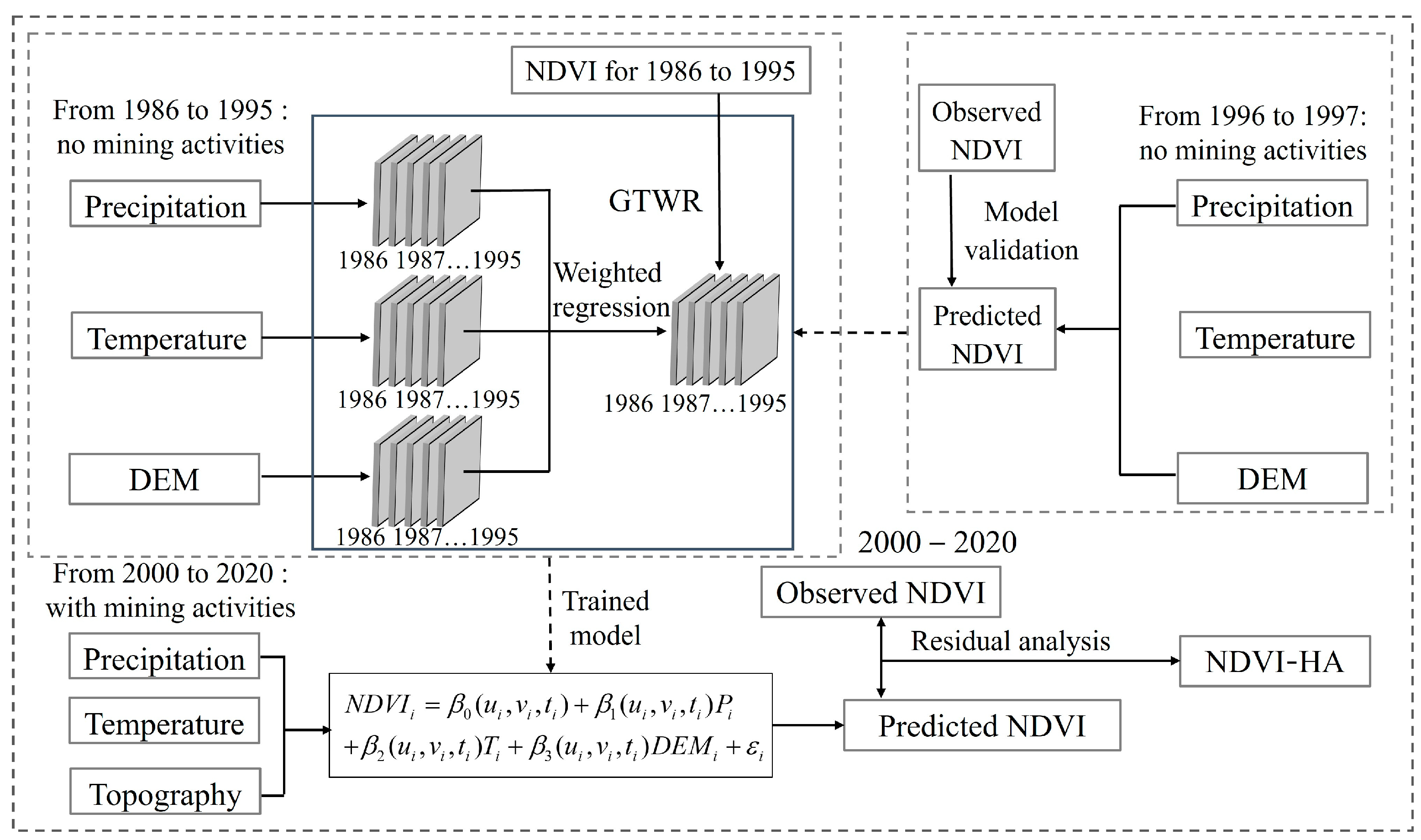

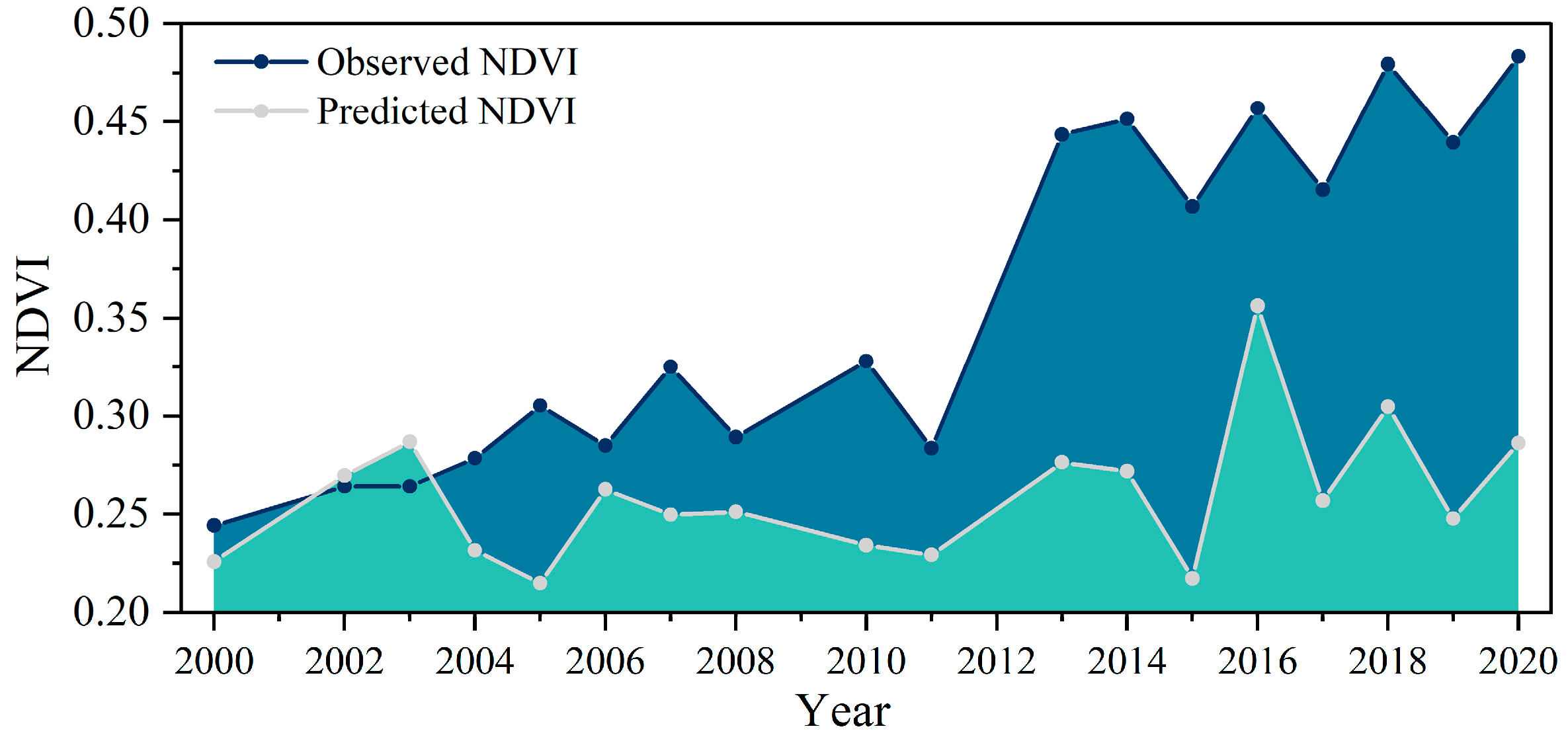
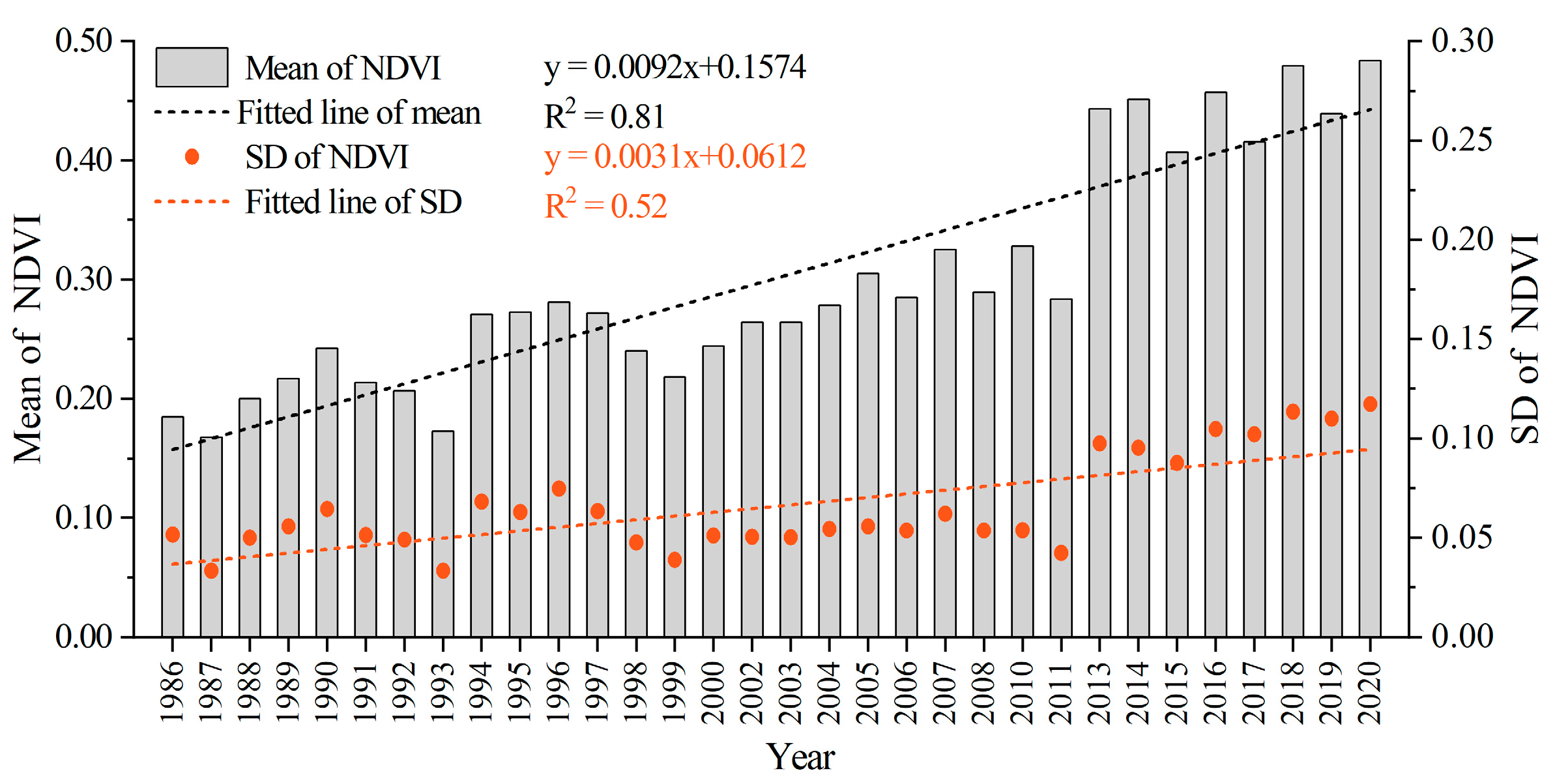
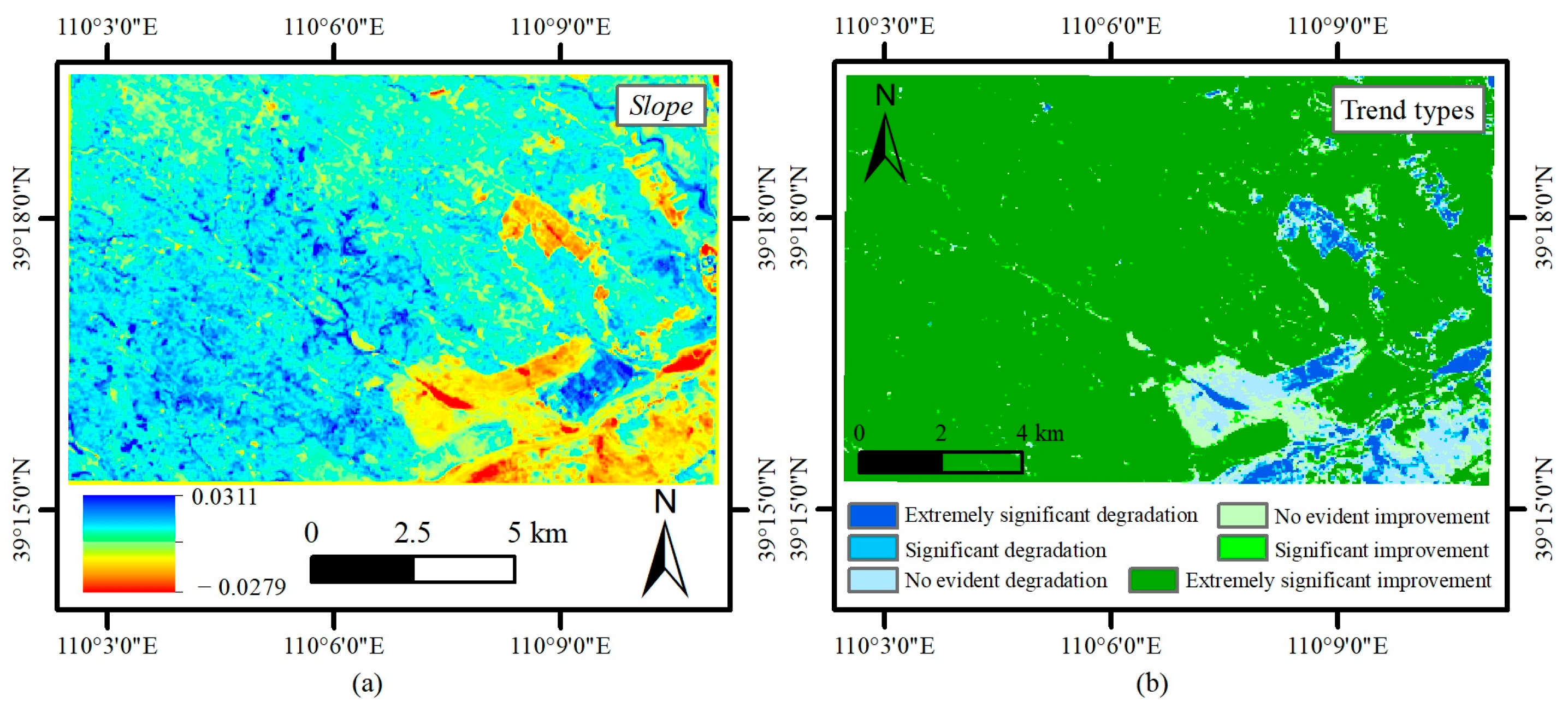
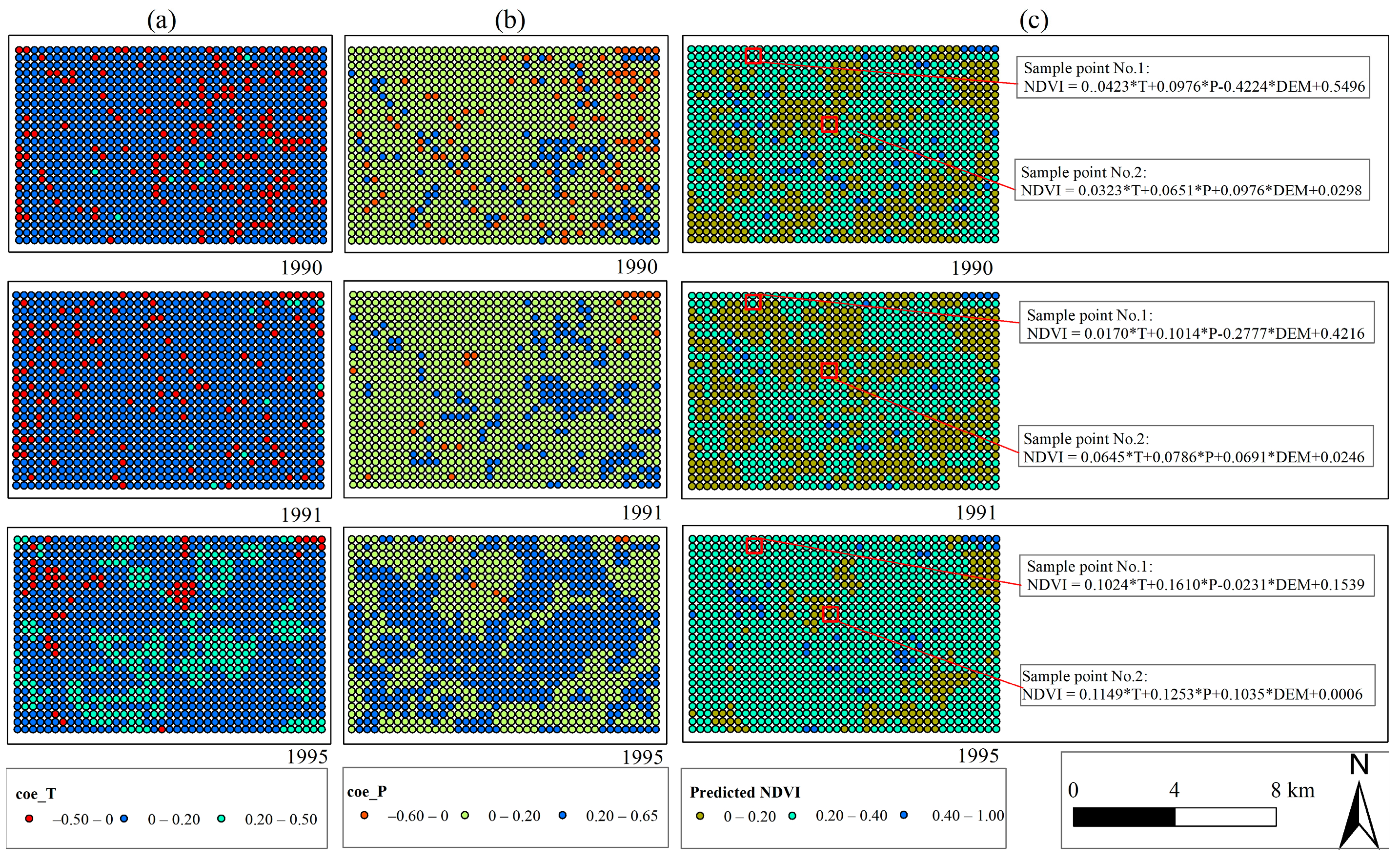





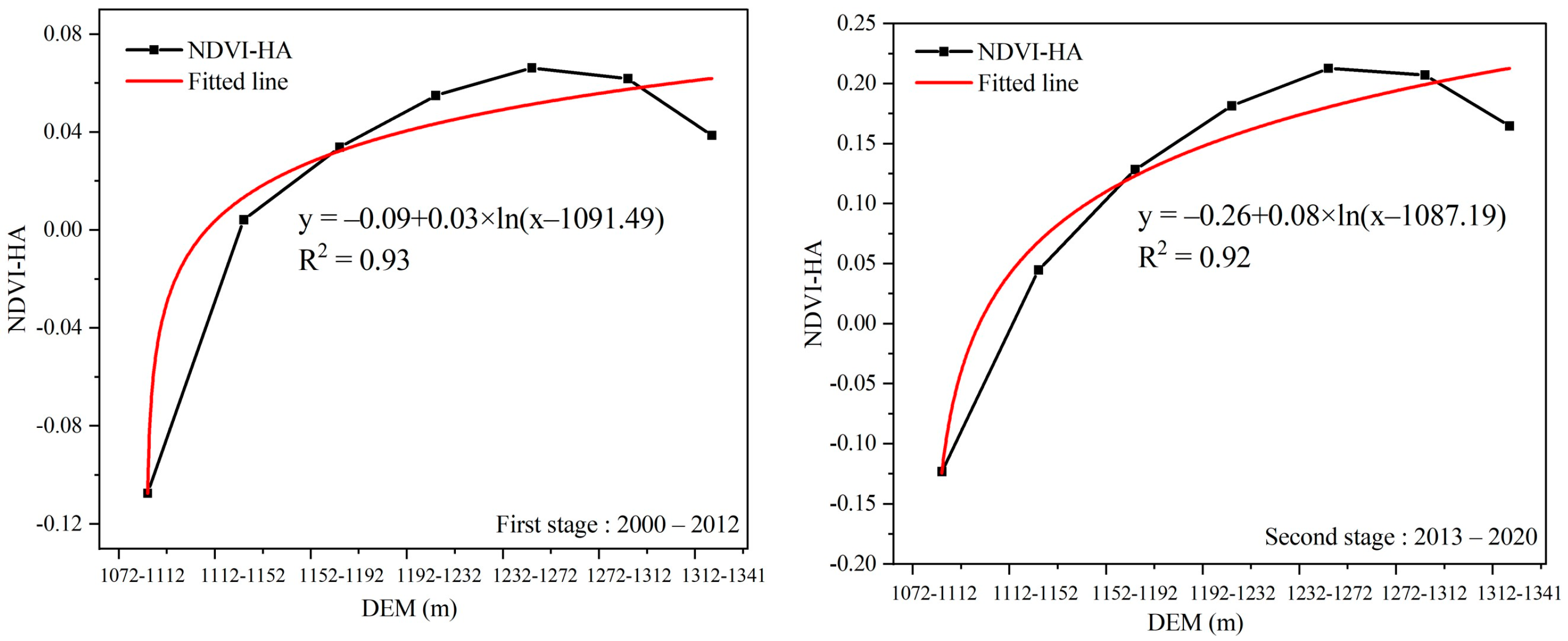
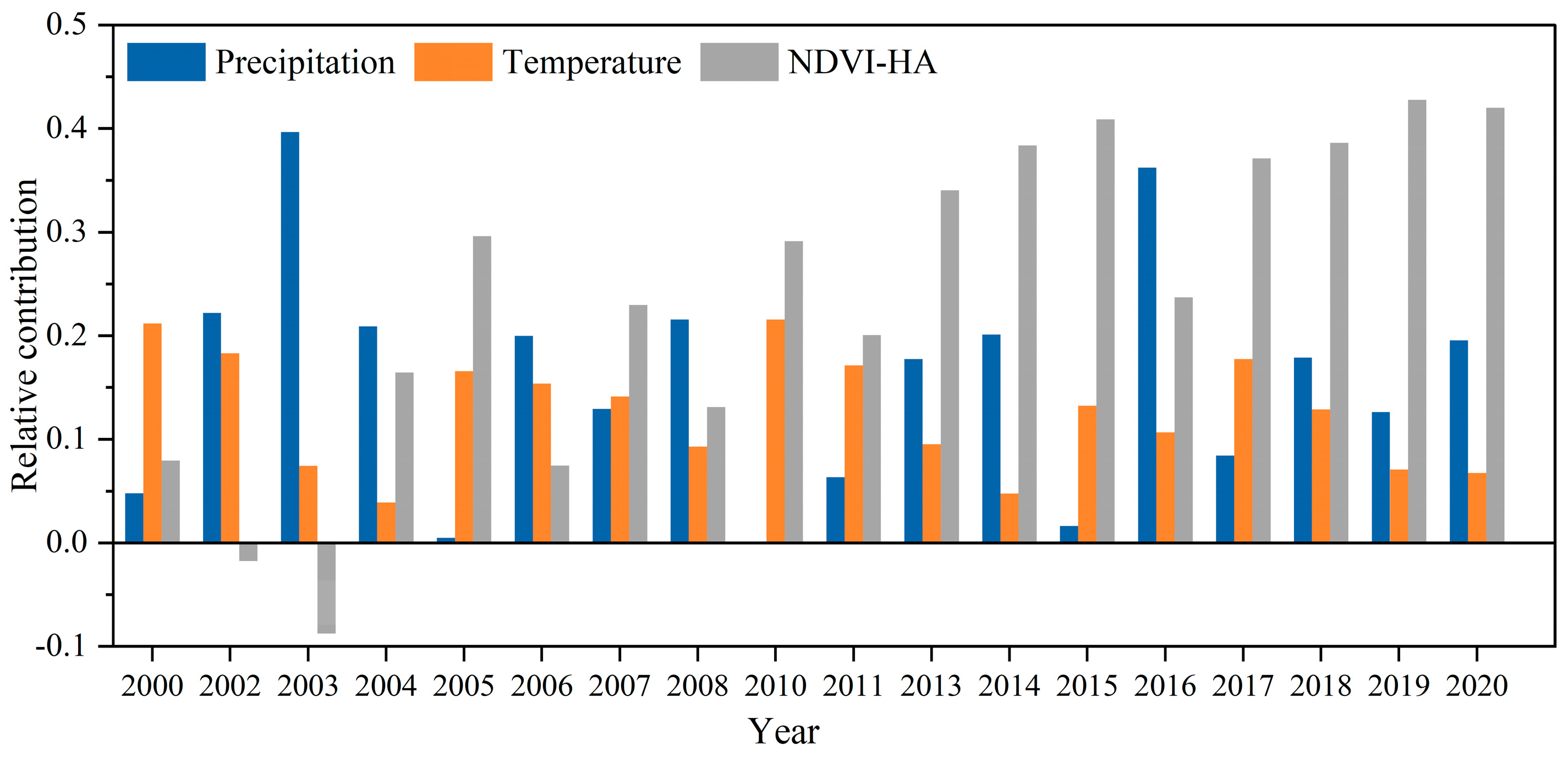
| Types | Names | Sources | Description |
|---|---|---|---|
| Remotely sensed images | Landsat 5/7/8 | Google Earth Engine (https://earthengine.google.com/) | Images of 1 July to 30 September from 1986 to 2020; the spatial resolution is 30 m. |
| Topographic data | ASTER GDEM V2 | Geospatial Data Cloud (http://www.gscloud.cn/) | The horizontal resolution is 30 m and the vertical resolution is 20 m. |
| Climatic and meteorological data | Temperature & Precipitation | China Meteorological Data Service Centre (http://data.cma.cn/) | Monthly dataset of surface climatic information from 1986–2020. |
| Slope | p-Value | Trend Types | Number of Pixels | Percentage |
|---|---|---|---|---|
| Slope < 0 | p < 0.01 | Extremely significant degradation | 3214 | 2.35% |
| Slope < 0 | 0.01 < p < 0.05 | Significant degradation | 1652 | 1.21% |
| Slope < 0 | p > 0.05 | No evident degradation | 6727 | 4.91% |
| Slope > 0 | p > 0.05 | No evident improvement | 7004 | 5.11% |
| Slope > 0 | 0.01 < p < 0.05 | Significant improvement | 2382 | 1.74% |
| Slope > 0 | p < 0.01 | Extremely significant improvement | 116,002 | 84.68% |
| NDVI & Precipitation | NDVI & Temperature | ||
|---|---|---|---|
| Months | Correlation | Months | Correlation |
| 7 | 0.879 ** | 7 | 0.424 |
| 8 | 0.522 | 8 | 0.433 |
| 9 | 0.797 | 9 | −0.235 |
| 1–7 | 0.266 | 1–7 | 0.257 |
| 1–8 | 0.322 | 1–8 | 0.242 |
| 1–9 | 0.341 | 1–9 | 0.177 |
| 7–8 | 0.832 * | 7–8 | 0.702 |
| 8–9 | 0.430 | 8–9 | 0.204 |
| 7–9 | 0.768 * | 7–9 | 0.294 |
Disclaimer/Publisher’s Note: The statements, opinions and data contained in all publications are solely those of the individual author(s) and contributor(s) and not of MDPI and/or the editor(s). MDPI and/or the editor(s) disclaim responsibility for any injury to people or property resulting from any ideas, methods, instructions or products referred to in the content. |
© 2024 by the authors. Licensee MDPI, Basel, Switzerland. This article is an open access article distributed under the terms and conditions of the Creative Commons Attribution (CC BY) license (https://creativecommons.org/licenses/by/4.0/).
Share and Cite
Guo, L.; Li, J.; Zhang, C.; Xu, Y.; Xing, J.; Hu, J. Evaluating the Impact of Human Activities on Vegetation Restoration in Mining Areas Based on the GTWR. ISPRS Int. J. Geo-Inf. 2024, 13, 132. https://doi.org/10.3390/ijgi13040132
Guo L, Li J, Zhang C, Xu Y, Xing J, Hu J. Evaluating the Impact of Human Activities on Vegetation Restoration in Mining Areas Based on the GTWR. ISPRS International Journal of Geo-Information. 2024; 13(4):132. https://doi.org/10.3390/ijgi13040132
Chicago/Turabian StyleGuo, Li, Jun Li, Chengye Zhang, Yaling Xu, Jianghe Xing, and Jingyu Hu. 2024. "Evaluating the Impact of Human Activities on Vegetation Restoration in Mining Areas Based on the GTWR" ISPRS International Journal of Geo-Information 13, no. 4: 132. https://doi.org/10.3390/ijgi13040132
APA StyleGuo, L., Li, J., Zhang, C., Xu, Y., Xing, J., & Hu, J. (2024). Evaluating the Impact of Human Activities on Vegetation Restoration in Mining Areas Based on the GTWR. ISPRS International Journal of Geo-Information, 13(4), 132. https://doi.org/10.3390/ijgi13040132









